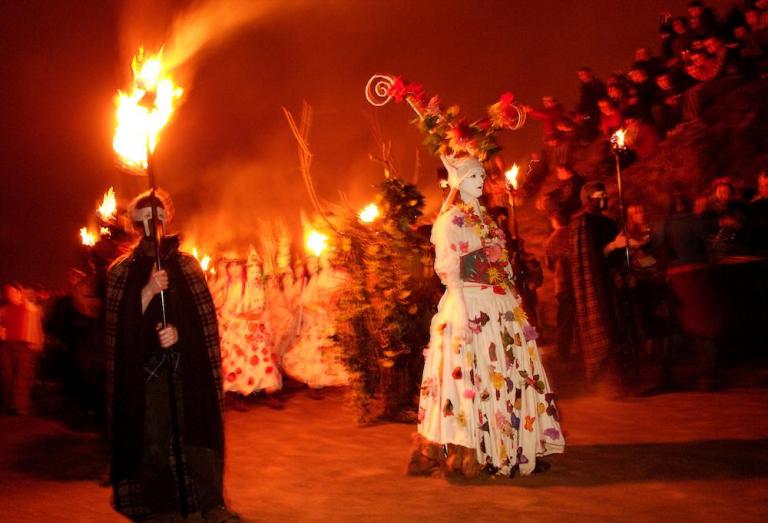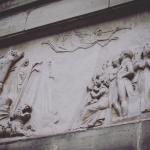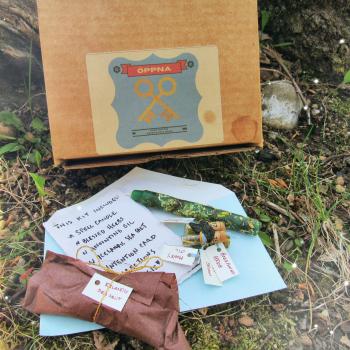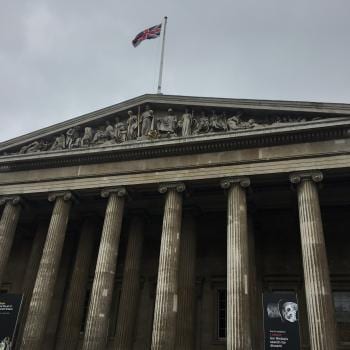
Beltane is one of the four (or eight, depending on the person) major Neo-Pagan/Wiccan holidays. It occurs on or around May 1 and continues to be practiced today under the guise of May Day celebrations. It is traditionally thought to be a festival of fire and fertility. In the Pagan “Wheel of the Year” it is known as the time when the Goddess welcomes the God as Her consort. Many consider this an auspicious time to join with a partner and it is common for Handfastings to occur. However, it is important to acknowledge that historical accounts may have been taken out of context and that the festival has been misrepresented as one that is primarily associated with fire.
The word Beltane is thought to come from the Celtic god Belenus and the Gaelic word for fire “teine”; essentially “The fires of Bel”. Belenus was one of the most prominent Celtic deities, and his worship spread from Italy all the way to Ireland. More than thirty archaeological finds have been associated with him; the most of any deity from the Celtic pantheon. The Romans associated him with Apollo, hence the reason many call him a sun god. However, there is no pre-Roman literature or evidence to support this theory. Rather, the Romans often adopted local gods from newly conquered territory by simply changing their name to the god or goddess that most closely correlated to the one from their own pantheon.
In today’s pagan celebrations, Beltane is characterized by large bonfires and sexual trysts. It is the festival most associated with sex magic and love; a time for all creatures to procreate. Another common practice is for people to leap over the flames of the bonfire; this stems from the practice of driving cattle between large fires in order to cleanse them of disease.
Our modern understanding of the festival comes from early records of the Beltane celebrations in books such as the clerical Sanais Chormaic (Knowledge of Cormac). In the 1868 translation by Whitley Stokes, two relevant entries are found.
“Bil from Bial i.e. an idol god, unde beltine – May day – i.e. fire of Bel.”
“Belltaine… lucky fire… two fires which Druids used to make with great incantations, and they used to bring the cattle [as a safeguard] against the diseases of each year to those fires…] ‘they used to drive the cattle between them’…”
Even from these two examples, we can easily see a discrepancy. In the first, “Bil” is said to be an idol god, whereas in the second it is said to mean “lucky fire”. We know from other historical accounts that this was also done at Midsummer, so it is not something exclusive to the celebrations around the 1st of May.
Our next source comes from one William Robert Wilde (curiously, the father of Oscar Wilde!). A native Irishman and doctor, his life’s passion was documenting the dying traditions of post-famine Ireland. In Irish Popular Superstitions (Dublin, 1852), he gives us the following:
“… As at the Midsummer festival so at the May fires… it was no uncommon practice in Connaught at least at the Midsummer fire to drive the cattle through the…warm ashes as a form of purification, and against witchcraft, fairies, murrain, blackleg, loss of milk and other misfortunes or diseases.” (p.50)
Wilde and most other historians simply assumed that the Beltane/May 1 was the original festival and that the tradition of bonfires and cattle saining (blessing or consecrating) was carried over to the Christian holiday of Midsummer. As we can see from the textual evidence, however, Midsummer was itself an important pagan holiday; and perhaps the fire traditions are actually remnants of the original belief, not the result of Christian interference.
Another article from 1869 (Religious Beliefs of the Pagan Irish) by J. O’Beirne Crowe offers this insight as well:
“The worship of the sun, as connected in popular tradition with May day, is quite a delusion. Beltaine…cannot possibly mean ‘Fire of Baal’, while at the same time the May fires of modern days are quite unknown to our olden records”(323).
What these texts suggest then, is that bonfires were not particular to the celebrations at Beltane. The practice of cleansing by using smoke and fire is found throughout many festivals and religious practices. In fact, almost all of the Gaelic celebrations were characterized by some sort of association to fire.
Beltane was, in fact, a celebration of the union of the various natural forces. Fires were, and are an absolutely essential element, yet there is no evidence to suggest that they were the core fixed detail of the rite. Equal importance was placed on flowers and vegetation, which would have just been coming back into bloom in the Northern Hemisphere. Water would also have been an important feature as the snow melt from the mountains would have caused a swell in the rivers and streams.
Wilde provides us with further insight into the importance of wells and springs during this time. The following quote from Irish Popular Superstitions (Dublin, 1852) is of particular note:
“…Farmers drive their flocks by daybreak to the wells that they may drink there before those of their neighbors, and the greatest rivalry prevails amongst the servant girls and milkmaids as to who should first draw water from the spring well upon May morning… ” (p.54)
So what is a modern day Pagan to make of this?
I, for one, still plan on jumping over the fire on Beltane. But I also plan to honor the other elements bursting into life at this time. Just yesterday, I went out behind my house to explore the woods. Having recently moved there this winter, I hadn’t been brave enough to face the snow which left me waiting for the arrival of spring. I was overcome with joy to discover that I have a swiftly flowing stream! After learning about the historical context of Beltane, I felt a peace. It makes sense to me to honor the newly awakened water and plants. Not that I don’t love a good bonfire (who doesn’t?) but I am going to make sure to celebrate the other elements as well.
Here are some ideas for honoring the change of season in your own life:
- Take a meditative walk in the woods, remove your shoes if you can. Look for new growth and fresh buds.
- Honor your local body of water. Bring an offering of fresh flowers and give it to the water (if you plan on putting it in the water, try and use wildflower or something without artificial dyes).
- Have a bonfire!! If you have a space to have one, do so! Or if you live in a city or don’t have a backyard, go to a state park or the beach. Join together with friends to celebrate and enjoy shared company. If you’re brave enough, take a leap over the flames! (if you really have no other options, light a few candles!).
- Most of all, be present. Be thankful. Honor the gods, yourself, and the people around you.
References:
Hutton, Ronald. “Modern Pagan Festivals: A Study in the Nature of Tradition.” Folklore 119, no. 3 (2008): 251-73.
Wallis, Robert J., and Jenny Blain. “Sites, Sacredness, and Stories: Interactions of Archaeology and Contemporary Paganism.” Folklore 114, no. 3 (2003): 307-21.
Whitley, Stokes. Sanas Chormaic: Cormac’s Glossary. (1868)
Wilde, William. Irish Popular Superstitions. (1852)
















